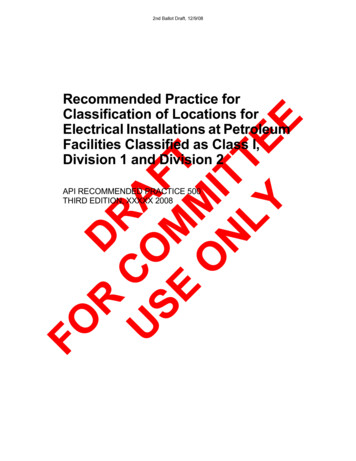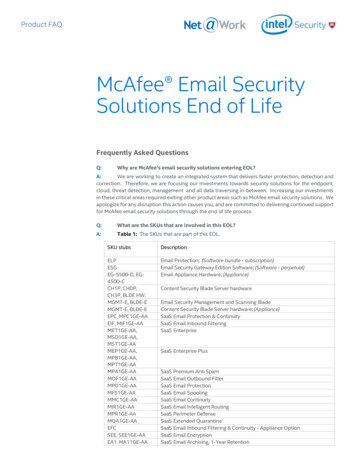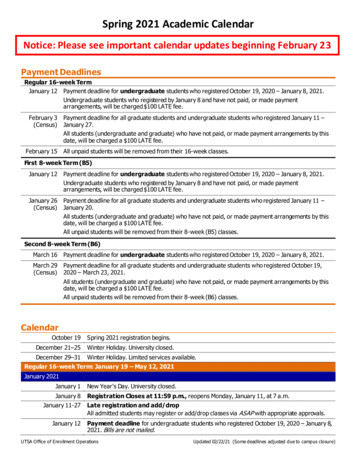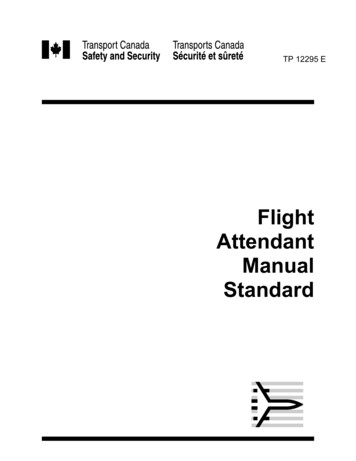
Transcription
PERSPECTIVEJanuary 2013Expanded EditionTHE SCHOOL PRINCIPAL AS LEADER:GUIDING SCHOOLS TO BETTERTEACHING AND LEARNINGi
Copyright 2013The Wallace FoundationAll rights reserved.This Wallace Perspective was produced as part of a commitment by The Wallace Foundation to develop and shareinformation, ideas and insights about how school leadership can contribute to improved student learning. It wasfirst published in 2012. Based on feedback from teachers, the 2013 expanded edition includes new articles aboutthe benefits of good principals for teaching. The ideas presented in this paper represent the collective efforts ofprogram, research and evaluation, communications and editorial staff members at Wallace. We particularly appreciate the contributions of James Harvey of James Harvey & Associates, Seattle, Wash., in the formulation anddrafting of this paper. Holly Holland, an education writer in Louisville, Ky., contributed the feature on DeweyHensley. H.J. Cummins, an editor and writer in Reston, Va., wrote the article on Sara Bonti.This report and other resources on school leadership cited throughout this paper can be downloaded for free atwww.wallacefoundation.org.Photos of Dewey Hensley by John Nation, courtesy of Louisville magazine, 2009; cover photo: Tim Pannell/Corbis; photo of Sara Bonti by John MorganDesign by José Morenoii10
THE SCHOOL PRINCIPAL AS LEADER:GUIDING SCHOOLS TO BETTERTEACHING AND LEARNING1
210
TABLE OF CONTENTS4Overview5The School Principal as Leader12How One Principal Transformed a School18 A Scholar’s View of thePrincipal-Teacher Connection21 Reflections on Leadership Froma Teacher3
THE PRINCIPAL AS LEADER: AN OVERVIEWEducation research shows that most school variables, considered separately, have at mostsmall effects on learning. The real payoff comes when individual variables combine to reachcritical mass. Creating the conditions under which that can occur is the job of the principal.For more than a decade, The Wallace Foundation has supported efforts to improve leadershipin public schools. In addition to funding projects in 28 states and numerous school districtswithin them, Wallace has issued more than 70 research reports and other publications covering school leadership, on topics ranging from how principals are trained to how they areevaluated on the job. Through all this work, we have learned a great deal about the nature ofthe school principal’s role, what makes for an effective principal and how to tie principal effectiveness to improved student achievement.This Wallace Perspective is a culling of our lessons to describe what it is that effective principals do. In short, we believe they perform five key practices well: Shaping a vision of academic success for all students. Creating a climate hospitable to education. Cultivating leadership in others. Improving instruction. Managing people, data and processes to fosterschool improvement.This Wallace Perspective is the first of a series looking at school leadership and how it is bestdeveloped and supported. In subsequent publications, we will look at the role of school districts, states and principal training programs in building good school leadership.410
INTRODUCTIONTen years ago, school leadership was noticeably absent from most major school reformagendas, and even the people who saw leadership as important to turning around failingschools expressed uncertainty about how to proceed.What a difference a decade makes.Today, improving school leadership ranks high on the list of priorities for school reform. Ina detailed 2010 survey, school and district administrators, policymakers and others declaredprincipal leadership among the most pressing matters on a list of issues in public school education. Teacher quality stood above everything else, butprincipal leadership came next, outstripping mattersincluding dropout rates, STEM (science, technology,engineering and math) education, student testing, andpreparation for college and careers.1A particularly noteworthyfinding is the empirical linkbetween school leadership andimproved student achievement.Meanwhile, education experts, through the updated(2008) Interstate School Leaders Licensure Consortiumstandards, have defined key aspects of leadership toguide state policy on everything from licensing to onthe-job training of principals. New tools are availablefor measuring principal performance in meaningfulways. And federal efforts such as Race to the Top areemphasizing the importance of effective principals in boosting teaching and learning. Payingattention to the principal’s role has become all the more essential as the U.S. Department of Education and state education agencies embark on transforming the nation’s 5,000 most troubledschools, a task that depends on the skills and abilities of thousands of current and future schoolleaders.Since 2000, The Wallace Foundation has supported numerous research studies on school leadership and published more than 70 reports on the subject. It has also funded projects in some28 states and numerous districts within them. Through that work, we now understand thecomplexities of school leadership in new and more meaningful ways.A particularly noteworthy finding, reinforced in a major study by researchers at the universities of Minnesota and Toronto, is the empirical link between school leadership and improvedstudent achievement.2 Drawing on both detailed case studies and large-scale quantitativeanalysis, the research shows that most school variables, considered separately, have at mostsmall effects on learning. The real payoff comes when individual variables combine to reachcritical mass. Creating the conditions under which that can occur is the job of the principal.Indeed, leadership is second only to classroom instruction among school-related factors thataffect student learning in school. “Why is leadership crucial?” the Minnesota and Toronto1Linda Simkin, Ivan Charner, Eliana Saltares and Lesley Suss, Emerging Education Issues: Findings From The Wallace FoundationSurvey, prepared for The Wallace Foundation by the Academy for Educational Development, unpublished, 2010, 9-10.2“In developing a starting point for this six-year study, we claimed, based on a preliminary review of research, that leadershipis second only to classroom instruction as an influence on student learning. After six additional years of research, we are even moreconfident about this claim.” Karen Seashore Louis, Kenneth Leithwood, Kyla L. Wahlstrom, Stephen E. Anderson, Learningfrom Leadership: Investigating the Links to Improved Student Learning: Final Report of Research to The Wallace Foundation,University of Minnesota and University of Toronto, 2010, 9.5
researchers ask. “One explanation is that leaders have the potential to unleash latent capacitiesin organizations.”3A University of Washington study employed a musical metaphor to describe three differentleadership approaches by principals.4 School leaders determined to do it all themselves were“one-man bands;” those inclined to delegate responsibilities to others operated like the leaderof a “jazz combo;” and those who believed broadlyin sharing leadership throughout the school could bethought of as “orchestral leaders,” skilled in helpinglarge teams produce a coherent sound, while encouraging soloists to shine. The point is that although in anyschool a range of leadership patterns exists – amongprincipals, assistant principals, formal and informalteacher leaders, and parents – the principal remains thecentral source of leadership influence.The principal remains thecentral source of leadershipinfluence.THE SCHOOL PRINCIPAL AS LEADERTraditionally, the principal resembled the middle manager suggested in William Whyte’s 1950’sclassic The Organization Man – an overseer of buses, boilers and books. Today, in a rapidlychanging era of standards-based reform and accountability, a different conception has emerged– one closer to the model suggested by Jim Collins’ 2001 Good to Great, which draws lessonsfrom contemporary corporate life to suggest leadership that focuses with great clarity on whatis essential, what needs to be done and how to get it done.This shift brings with it dramatic changes in what public education needs from principals.They can no longer function simply as building managers, tasked with adhering to districtrules, carrying out regulations and avoiding mistakes. They have to be (or become) leaders oflearning who can develop a team delivering effective instruction.Wallace’s work since 2000 suggests that this entails five key responsibilities:610 Shaping a vision of academic success for all students, one based on high standards. Creating a climate hospitable to education in order that safety, a cooperative spirit andother foundations of fruitful interaction prevail. Cultivating leadership in others so that teachers and other adults assume their parts inrealizing the school vision. Improving instruction to enable teachers to teach at their best and students to learn totheir utmost. Managing people, data and processes to foster school improvement.3Seashore Louis, Leithwood et al., 9.4Bradley Portin, Paul Schneider, Michael DeArmond and Lauren Gundlach. Making Sense of Leading Schools: A Study of theSchool Principalship, University of Washington, 2003, 25-26.
Each of these five tasks needs to interact with the other four for any part to succeed. It’s hardto carry out a vision of student success, for example, if the school climate is characterized bystudent disengagement, or teachers don’t know what instructional methods work best for theirstudents, or test data are clumsily analyzed. When all five tasks are well carried out, however,leadership is at work.FIVE KEY PRACTICES1.Shaping a vision of academic success for all studentsAlthough they say it in different ways, researchers who have examined education leadershipagree that effective principals are responsible for establishing a schoolwide vision of commitment to high standards and the success of all students.Newcomers to the education discussion might find this puzzling: Hasn’t concern with the academic achievement of every student always topped principals’ agendas? The short answer is,no. Historically, public school principals were seen as school managers,5 and as recently as twodecades ago, high standards were thought to be the province of the college bound. “Success”could be defined as entry-level manufacturing work for students whohad followed a “general track,” andlow-skilled employment for dropouts. Only in the last few decadeshas the emphasis shifted to academic expectations for all.“Having high expectations for all isone key to closing the achievementgap between advantaged and lessadvantaged students.”This change comes in part as a response to twin realizations: Careersuccess in a global economy depends on a strong education; for allsegments of U.S. society to be able to compete fairly, the yawning gap in academic achievementbetween disadvantaged and advantaged students needs to narrow. In a school, that begins witha principal’s spelling out “high standards and rigorous learning goals,” Vanderbilt Universityresearchers assert with underlined emphasis. Specifically, they say, “The research literature overthe last quarter century has consistently supported the notion that having high expectations forall, including clear and public standards, is one key to closing the achievement gap between advantaged and less advantaged students and for raising the overall achievement of all students.” 6An effective principal also makes sure that notion of academic success for all gets picked upby the faculty and underpins what researchers at the University of Washington describe as aschoolwide learning improvement agenda that focuses on goals for student progress.7 Onemiddle school teacher described what adopting the vision meant for her. “My expectationshave increased every year,” she told the researchers. “I’ve learned that as long as you supportthem, there is really nothing [the students] can’t do.”85Seashore Louis, Leithwood et al., 78.6Andrew C. Porter, Joseph Murphy, Ellen Goldring, Stephen N. Elliott, Morgan S. Polikoff and Henry May, Vanderbilt Assessmentof Leadership in Education: Technical Manual, Version 1.0, Vanderbilt University, 2008, 13.7Michael S. Knapp, Michael A. Copland, Meredith I. Honig, Margaret L. Plecki, and Bradley S. Portin, Learning-focused Leadershipand Leadership Support: Meaning and Practice in Urban Systems, University of Washington, 2010 , 2.8Bradley S. Portin, Michael S. Knapp, Scott Dareff, Sue Feldman, Felice A. Russell, Catherine Samuelson and Theresa Ling Yeh,Leadership for Learning Improvement in Urban Schools, University of Washington, 2009, 55.7
“Seek Out the Best Preparation You Can Find”Advice to Teachers Interested in Becoming a Principal“There’s a tradition of teachers who are really excellentexemplars in the classroom of saying, ‘I don’t want to be a principalbecause it has nothing to do withinstruction,’” says Linda DarlingHammond, a leading authority oneducation policy and the teachingprofession. [See q&a with heron pg 18.] “But one of the thingswe found in our study was that assome of those people were reachedout to and got the message thatbeing a principal could be about building the quality of instruction, they said, ‘Oh, well I mightactually want to do that.’ They’vebecome spectacular school prin-cipals, and we’ve seen them in action. So number one, do it if that’swhat you’re passionate about.“Number two, seek out the bestpreparation you can find forinstructional management, fororganizational development, forchange management – for thesethings that we know matter because [being a principal] is a different use of your skills and talents.There is a broader knowledge baseto capture, and not every place youmay look to to build your skillswill have those pieces in place. Beaggressive about finding the rightsupport and training for yourself.“Third, collaborate, collaborate,collaborate. Go into this with theidea that, ‘I’m going to build ateam. It’s not going to just haveto be me. My job is to really findthe expertise and the skills and theabilities of the people that I workwith, cultivate those, glue themtogether.’ You will be both a moresuccessful principal and you willbe a saner principal who has atleast a little bit of a life beyond allof the effort that you put into thework in the schools.”So, developing a shared vision around standards and success for all students is an essential element of school leadership. As the Cheshire cat pointed out to Alice, if you don’t know whereyou’re going, any road will lead you there.2.Creating a climate hospitable to educationEffective principals ensure that their schools allow both adults and children to put learning at the center of their daily activities. Such “a healthy school environment,” as Vanderbiltresearchers call it, is characterized by basics like safety and orderliness, as well as less tangiblequalities such as a “supportive, responsive” attitude toward the children and a sense by teachers that they are part of a community of professionals focused on good instruction.9Is it a surprise, then, that principals at schools with high teacher ratings for “instructionalclimate” outrank other principals in developing an atmosphere of caring and trust? Or thattheir teachers are more likely than faculty members elsewhere to find the principals’ motivesand intentions are good?10One former principal, in reflecting on his experiences, recalled a typical staff meeting years agoat an urban school where “morale never seemed to get out of the basement.” Discussion centered on “field trips, war stories about troubled students, and other management issues” ratherthan matters like “using student work and data to fine-tune teaching.” Almost inevitably,9Ellen Goldring, Andrew C. Porter, Joseph Muprhy, Stephen N. Elliott, Xiu Cravens, Assessing Learning-Centered Leadership:Connections to Research, Professional Standards and Current Practices, Vanderbilt University, 2007, 7-8.10 Seashore Louis, Leithwood et al., 81.810
teacher pessimism was a significant barrier, with teachers regarding themselves as “hardworking martyrs in a hopeless cause.”11To change this kind of climate – and begin to combat teacher isolation, closed doors, negativism, defeatism and teacher resistance – the most effective principals focus on building a senseof school community, with the attendant characteristics. These include respect for every member of the school community; “an upbeat, welcoming, solution-oriented, no-blame, professional environment;” and efforts to involve staff and students in a variety of activities, manyof them schoolwide.12Engaging parents and the community: continued interest, uncertain evidenceMany principals work to engage parents and others outside the immediate school community,such as local business people. But what does it take to make sure these efforts are worth thetime and toil required? While there is considerable interest in this question, the evidence onhow to answer it is relatively weak. For example, the Minnesota-Toronto study found thatin schools with higher achievement on math tests, teachers tended to share in leadership andbelieved that parents were involved with the school. The researchers noted, however, that “therelationships here are correlational, not causal,” and the finding could be at odds with anotherfinding from the study.13 Separately,the VAL-ED principal performanceassessment (developed with supportfrom The Wallace Foundation) measures principals on community andparent engagement.14 Vanderbilt researchers who developed the assessment are undertaking further studyon how important this practice is inaffecting students’ achievement. Inshort, the principal’s role in engaging the external community is littleunderstood.Principals play a major role indeveloping a “professional community”of teachers who guide one another inimproving instruction.3.Cultivating leadership in othersA broad and longstanding consensus in leadership theory holds that leaders in all walks oflife and all kinds of organizations, public and private, need to depend on others to accomplishthe group’s purpose and need to encourage the development of leadership across the organization.15 Schools are no different. Principals who get high marks from teachers for creating astrong climate for instruction in their schools also receive higher marks than other principalsfor spurring leadership in the faculty, according to the research from the universities of Minnesota and Toronto.1611 Knapp et al., 1, citing Kim Marshall from “A Principal Looks Back: Standards Matter,” Phi Delta Kappan, October 2003, 104113, and noting Marshall is also cited in Charles M. Payne’s So Much Reform, So Little Change: The Persistence of Failure inUrban Schools, 2008, 33-34.12 Portin, Knapp et al., p. 59.13 Seashore Louis, Leithwood et al., 116-118.14 Andrew C. Porter, Joseph Murphy, et al., Vanderbilt Assessment of Leadership in Education, 15.15 See for example, J.W. Gardner, On Leadership, The Free Press, 1993; J. Kouzes, J. and B. Posner, The Leadership Challenge:How to Keep Getting Extraordinary Things Done in Organizations, Jossey-Bass Publishers, 2008; and G. Yukl, Leadership inOrganizations, Prentice-Hall, 2009.16 Seashore Louis, Leithwood et al., 81-829
In fact if test scores are any indication, the more willing principals are to spread leadershiparound, the better for the students. One of the most striking findings of the universities ofMinnesota and Toronto report is that effective leadership from all sources – principals, influential teachers, staff teams and others – is associated with better student performance on mathand reading tests.The relationship is strong albeit indirect: Good leadership, the study suggests, improves bothteacher motivation and work settings. This, in turn, can fortify classroom instruction. “Compared with lower-achieving schools, higher-achieving schools provided all stakeholders withgreater influence on decisions,” the researchers write.17 Why the better result? Perhaps this is acase of two heads – or more – being better than one: “The higher performance of these schoolsmight be explained as a consequence of the greater access they have to collective knowledgeand wisdom embedded within their communities,” the study concludes.18Principals may be relieved to find out, moreover, that their authority does not wane as others’waxes. Clearly, school leadership is not a zero-sum game. “Principals and district leaders havethe most influence on decisions in all schools; however, they do not lose influence as othersgain influence,” the authors write. 19 Indeed, although “higher-performing schools awardedgreater influence to most stakeholders little changed in these schools’ overall hierarchicalstructure.”20University of Washington research on leadership in urban school systems emphasizes the needfor a leadership team (led by the principal and including assistant principals and teacher leaders) and shared responsibility for student progress, a responsibility “reflected in a set of agreements as well as unspoken norms among school staff.”21Effective principals studied by the University of Washington urged teachers to work with oneanother and with the administration on a variety of activities, including “developing and aligning curriculum, instructional practices, and assessments; problem solving; and participating inpeer observations.”22 These leaders also looked for ways to encourage collaboration, payingspecial attention to how school time was allocated. They might replace some administrativemeeting time with teacher planning time, for example.23 The importance of collaboration getsbacking from the Minnesota-Toronto researchers, too. They found that principals rated highlyfor the strength of their actions to improve instruction were also more apt to encourage thestaff to work collaboratively.24More specifically, the study suggests that principals play a major role in developing a “professional community” of teachers who guide one another in improving instruction. This isimportant because the research found a link between professional community and higher stu-17 Seashore Louis, Leithwood, 35.18 Seashore Louis, Leithwood, 35.19 Seashore Louis, Leithwood, 19.20 Seashore Louis, Leithwood, 35.21 Knapp, Copland et al., 322 Portin, Knapp et al., 56.23 Portin, Knapp et al., 59.24 Seashore Louis, Leithwood et al., 82.10
dent scores on standardized math tests.25 In short, the researchers say, “When principals andteachers share leadership, teachers’ working relationships with one another are stronger andstudent achievement is higher.”26What does “professional community” look like? Its components include things like consistentand well-defined learning expectations for children, frequent conversations among teachersabout pedagogy, and an atmosphere in which it’scommon for teachers to visit one another’s classrooms to observe and critique instruction.27Most principals would welcome hearing what oneurban school administrator had to say about howteam-based school transformation works at its best:“like a well-oiled machine,” with results that couldbe seen in “student behavior, student conduct, andstudent achievement.”284.A central part of being a greatleader is cultivating leadershipin others.Improving instructionEffective principals work relentlessly to improve achievement by focusing on the quality ofinstruction. They help define and promote high expectations; they attack teacher isolation andfragmented effort; and they connect directly with teachers and the classroom, University ofWashington researchers found.29Effective principals also encourage continual professional learning. They emphasize researchbased strategies to improve teaching and learning and initiate discussions about instructionalapproaches, both in teams and with individual teachers. They pursue these strategies despitethe preference of many teachers to be left alone.30In practice this all means that leaders must become intimately familiar with the “technical core”of schooling – what is required to improve the quality of teaching and learning.31Principals themselves agree almost unanimously on the importance of several specific practices, according to one survey, including keeping track of teachers’ professional developmentneeds and monitoring teachers’ work in the classroom (83 percent).32 Whether they call itcontinued on pg 1425 Seashore Louis, Leithwood et al., 48.26 Seashore Louis, Leithwood et al., 282.27 Seashore Louis, Leithwood et al., 45.28 Portin, Knapp et al., 56.29 Portin, Knapp et al., v.30 Seashore Louis, Leithwood et al., 77, 91.31 Kenneth Leithwood, Karen Seashore Louis, Stephen Anderson, Kyla Wahlstrom, Review of Research: How Leadership InfluencesStudent Learning, University of Minnesota and University of Toronto, 2004, 24.32 Seashore Louis, Leithwood et al., 71.11
A PROFILE IN LEADERSHIP: DEWEY HENSLEYNearly all 390 students at Louisville’s J. B. Atkinson Academy for Excellence in Teaching and Learning livein poverty. But from 2006 to 2011, principal Dewey Hensley showed this needn’t stand in the way of theirsucceeding in school. Under Hensley’s watch, students at Atkinson, once one of the lowest performing elementaryschools in Kentucky, doubled their proficiency rates in reading, math and writing. Most recently, the school wasone of only 17 percent in the school district that met all of its “adequate yearly progress” goals under the federalNo Child Left Behind Act.Hensley’s is not a tale of lonely-at-the-top heroics, however. Rather, it is a story about leadership that combines afirm belief in each child’s potential with an unrelenting focus on improving instruction – and a conviction that principals can’t go it alone. “Building a school is not about bricks,” Hensley says. “It’s about teachers. From inside out,you have to build the strengths. I’m not the leader. I’m a leader. I’ve tried to build strong leaders across the board.”Today Hensley is chief academic officer of Jefferson County, Ky., Public Schools. Principals there and elsewherecould learn a lot from how he led Atkinson with a style that mirrors in many ways the characteristics of effectiveschool leadership identified in research.Shaping a vision of academic success for all studentsHis first week on the job, Hensley drew a picture of a school on poster board and asked the faculty to annotateit. “Let’s create a vision of a school that’s perfect,” he recalls telling them, adding: “When we get there, then we’llrest.” Hensley, the first person in his extended family to graduate from high school and then college, sought toinstill in his staff the idea that all children could learn, with appropriate support. “I understand the power of aschool to make a difference in a child’s life,” he says. “They [all] have to have someone who will give them dreamsthey may not have.”Creating a climate hospitable to educationSchool suspensions at Atkinson were among the highest in the state when Hensley took over. Determined to createa more suitable climate for learning, Hensley visited the homes of the 25 most frequent student offenders, tell-1210
ing the families that their children would be protected, but other children would be protected from them, too, ifnecessary. Hensley brought in teams to diagnose each child’s academic and emotional needs and develop individual“prescriptions” that might include anything from home visits to intensive tutoring to eyeglasses. Chess club, aspecial program for truant students and ballroom dancing lessons culminating in a formal candlelit dinner thatincluded students’ parents were other tone-changers, along with school corridors with names like Teamwork Trailand street signs directing students 982 miles to Harvard or 2,352 miles to Stanford.Cultivating leadership in othersHensley set up a leadership structure with two notable characteristics. First, it was simple, comprising only threecommittees: culture, climate, and community; instructional leadership; and student support. Second, it madeleadership a shared enterprise. The committees were populated and headed by teachers, with every faculty member assigned to one. “I relinquished leadership in order to get control,” Hensley says. “I asked people to be aboutleadership.”He also encouraged his teachers to learn from one another. Science teacher Heather Lynd recalls the day Hensleyvisited her classroom and then asked her to lead a faculty meeting on anchor charts, annotated diagrams that canbe used to explain everything from the water cycle to punctuation tips. “He’s built on teachers’ strengths to sharethem with others,” says reading specialist Lori Atherton. “That creates leadership.”Improving instructionHensley did a lot of first-hand observation in classrooms, leaving behind detailed notes for teachers, sharing“gold nuggets” of exemplary practices, things to think about and next steps for improvement. He also introducedcutting-edge professional development, obtaining a grant to set up the ideal classroom in the building, full of technology and instructional resources. And he formed a collaboration with the University of Louisville. In one project,professors observed how Atkinson’s teachers kept students engaged and shared the collected data with the facultyin addition to using it for a research study.Hensley also encouraged teachers to do skill building on their own. As a result, Atkinson teachers began attainingcertification at a feverish pace from the National Board for Professional Teaching Standards, a private group thatoffers teachers an advanced credential based on rigorous standards. Finally, Hensley focused on getting studentsthe instruction that tests and observations showed they needed. For example, Hensley paired struggling 1st, 2nd and3rd graders
This report and other resources on school leadership cited throughout this paper can be downloaded for free at . www.wallacefoundation.org. Photos of Dewey Hensley by John Nation, courtesy of Louisville magazine, 2009; cover photo: Tim Pannell/ . Joseph










